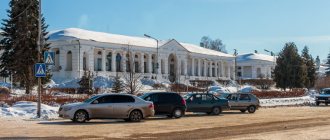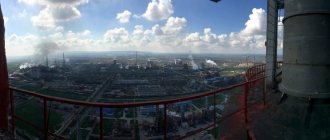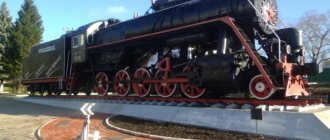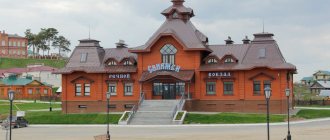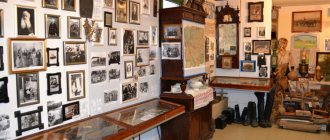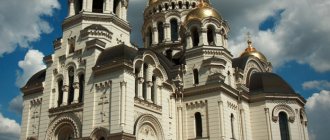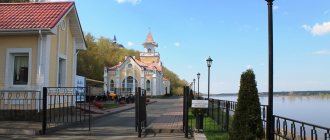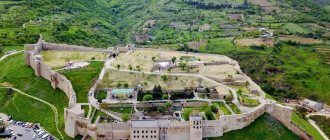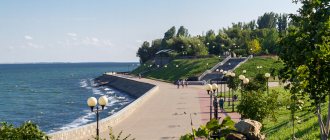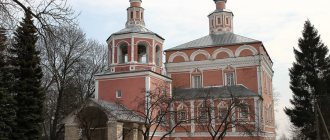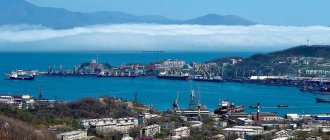Museum of Orenburg History
Museum of Orenburg History
Orenburg
The Museum of the History of Orenburg opened in 1983 to mark the 240th anniversary of the city. The red brick building where the museum is located was built in the mid-19th century. Initially, there was an archive, treasury and city relics here, and later the building began to be used as a guardhouse - a prison for the military existed here until the 70s of the 20th century.
Among the permanent exhibitions are “The Founding of Orenburg”, “Multinational Orenburg”, “The Peasant War under the leadership of Emelyan Pugachev”, “Pushkin in the Orenburg Region” and others. The “Farewell to the 20th Century” collection presents ladies' costumes from the beginning of the last century, accessories, paintings, dishes, children's toys and banknotes that were in circulation from 1901 to the present day.
Beautiful places in nature, outside the city
City monuments are not the only thing that the Orenburg region is famous for. A lot of impressions are guaranteed outside the city. Especially if you come at the most fertile time, at the end of July, in August. During this period, nature is bright, rich and has not yet had time to begin to prepare for the winter cold.
One vacation is not enough to travel to all the places. It is recommended to make a travel plan in advance and not try to cover the maximum in one.
GPS works uninterruptedly in the region, so it will be easy to navigate, even if you go out as “savages” with tents, sleeping bags, and kettles. Not far from the city “stuffiness” there is a river, sea, mountains, and forests. Camp sites and resorts offer services to lovers of cultural leisure. The places are attractive for both solo excursions and family trips.
Mount Grebeny
Among beginners, the route along Mount Greben is popular among tourists. It is located just 10 km from the city, near the 25th kilometer railway platform. In winter there is a ski resort here, and in summer there is a tourist base.
There are different types of recreation available here:
- mountain biking;
- walks in the fresh air through the forests;
- swimming in the Sakmara River;
- rafting to Tatar Kargaly.
Some types of recreation will go better with instructors, if the route is previously agreed upon. Especially if you wanted to climb to the top of the Ridges for the first time. It offers an amazing view; just seeing a photo of the nature of the Orenburg region once will make you want to visit this place.
Yacht club "Ural"
If you are more interested in water tourism, it is worth going to the Ural recreation center. It is located just 4 km from the central city of the Orenburg region. It offers rentals of jet skis, jet skis, skis, buns and banana boats. An experienced instructor will teach you how to use the equipment, so all that remains is to choose entertainment and hope for great weather.
There is also a more relaxing holiday - walks on a river tram or longboat. There is also a well-maintained beach, trampolines, a rope park and other attractions. If desired, a house and a gazebo with barbecue are available for rent. Many people get to the base by bicycle or even on foot.
Gallery "Orenburg downy scarf"
Gallery "Orenburg downy scarf"
Orenburg
The Orenburg down scarf is one of the main symbols of the Orenburg region. The down knitting industry originated here in the 18th century. The Orenburg Down Shawl gallery was opened in the city in 2012.
The gallery introduces the world's only collection of Orenburg down scarf - talks about the history of artistic craft, fashion and the attributes of folk and urban women's costume. Here you can see ancient tools of craftswomen - spinning wheels, spindles, combs for combing goat fluff. The oldest exhibit is an openwork cobweb from the beginning of the 20th century, which was donated to the museum by the Butovsky family. The weight of the product is only 40 grams.
Church of Dmitry Slunsky
The ancient temple, built in the 19th century, was closed during the years of Soviet power and converted into a cinema. The original painting and the faces of the saints were painted over.
The building was returned to the jurisdiction of the diocese only in 1990. Restoration work lasted two decades. The artists managed to recreate an ancient wall painting. The temple looks elegant and solemn.
Address: st. Popova, 98.
Orenburg Regional Museum of Fine Arts
Orenburg Regional Museum of Fine Arts
Orenburg
The Orenburg Museum of Fine Arts opened in 1961. It is housed in a building from the early 19th century, designed by architect Mikhailo Malakhov for the City Duma. The museum collection is based on a collection of paintings by academician of painting, representative of the late Wanderers movement, Lukian Popov.
The museum houses works of Russian and Western European art from the end of the 16th century to the present day. Among the 19th-century paintings are works by Ivan Aivazovsky, Lev Lagorio, Alexey Savrasov, Nikolai Dubrovsky, Vladimir Makovsky, Vasily Polenov and Philip Malyavin.
Water tower
Looking at this structure, it’s hard to believe that the building is more than a hundred years old. In 1904, at the intersection of modern Pobeda and Zhukov avenues, a revolutionary structure for those times was built.
The tower was intended for water purification. The useful volume was about 80 buckets. The water tower was the first step towards the rapid development of the city.
The architectural monument has been restored and makes a good impression. The building is located on the street. Gorky, 57.
Orenburg Regional Drama Theater named after. M. Gorky
Orenburg Regional Drama Theater named after M. Gorky
Orenburg
The first city entrepreneur Boris Solovyov is called the founder of the Orenburg Theater - in 1856 he created a troupe of professional actors in Orenburg. At first, performances were given in the hall of the Noble Assembly; later, the stone arena of the Neplyuevsky School was equipped for the theater - a renovated building with an expanded stage and a rebuilt foyer opened in 1869.
The Orenburg Theater was one of the first in Russia to stage plays by Anton Chekhov - in 1898, the premiere of the play “The Seagull” took place here. Then productions based on the works of Maxim Gorky appeared in the repertoire - since 1932 the theater has been named after him.
Pedestrian bridge over the Urals
The main symbols of Orenburg, depicted on almost all souvenirs of the city, are the descent to the Ural River and the Europe-Asia . The white stone staircase was built just to the right of the historical descent to the river in 1955.
From here you can immediately get to the famous pedestrian bridge connecting two parts of the world. Since the Ural River is a geographical border, crossing the bridge across it allows you to make a unique journey from Asia to Europe. Most tourists prefer the funicular. This is one of the modern cable cars in Russia.
Cathedral of St. Nicholas the Wonderworker in Forshtadt in Orenburg
Cathedral of St. Nicholas the Wonderworker in Forshtadt in Orenburg
Orenburg region
In the Cossack village of Forstadt, the territory of which today belongs to Orenburg, a parish church was founded in 1883. In the same year, the future Russian Emperor Tsarevich Nicholas presented the cathedral under construction with an altar Gospel under a metal frame with images of the apostles in the four corners. In 1886, the church was consecrated in honor of St. Nicholas the Wonderworker.
In Soviet times, out of forty parishes and city Orthodox churches, only the looted and closed St. Nicholas Church remained intact. After the war the church was opened. In the 50s, the Orenburg artist Vladimir Rublev re-painted the walls of the church, and in the 90s the cathedral was restored, a new dome was installed, a bell tower and a water-sanctuary chapel were built.
Merchant houses
Numerous merchants of Orenburg fell so in love with the new architectural style that arose at the turn of the 19th – 20th centuries that even the term “merchant modern” appeared. Along the streets of Chicherin, Yaitskaya, Kirov, Sovetskaya, one can still find strong houses of Orenburg merchants, built in a similar style.
Examples of such architecture include:
- House of merchant Korobkov on Chicherin Street.
- The house of the merchant Pankratov at the intersection of Kirov and Matrossky. It featured the first passenger elevator in Orenburg.
Temple of Our Lady of Loreto in Orenburg
Temple of Our Lady of Loreto in Orenburg
Orenburg region
After the divisions of the Polish-Lithuanian Commonwealth in the 18th century, a large number of Poles were exiled to Orenburg - then the first Catholics appeared in these parts. In 1847, a Catholic church was built in the city, which was consecrated in honor of the Loretan Mother of God. The first Catholic priest of the city was Father Kandid Zelenko.
During Soviet times, the church was closed; until the 90s, a tannery workshop was located here. Only in 1997 - exactly 150 years after the first consecration - the temple was re-consecrated by Archbishop Tadeusz Kondrusiewicz.
Church of St. John the Evangelist
It is impossible not to notice the beautiful temple on Grigorievskaya Street. Red brick walls, green domes, well-groomed territory around - the temple makes an impression on believers of Orenburg and tourists.
The church was erected in 1902. In the first years after its construction, it housed a women's parochial school. The school has now been moved to another building.
petting zoo
The cozy zoo is a popular attraction in Orenburg. You won't find a tiger, lion or bear here. Zoo inhabitants are not dangerous to humans. You can pet them, feed them, and take a photo with them.
Animals live in open enclosures. The zoo area is well-groomed and clean. Safety meets all accepted standards.
Address: st. Postnikova, 30, near the city center.
